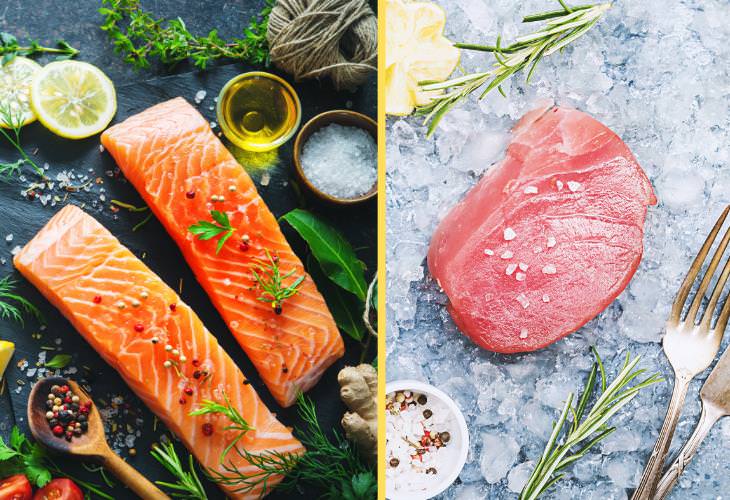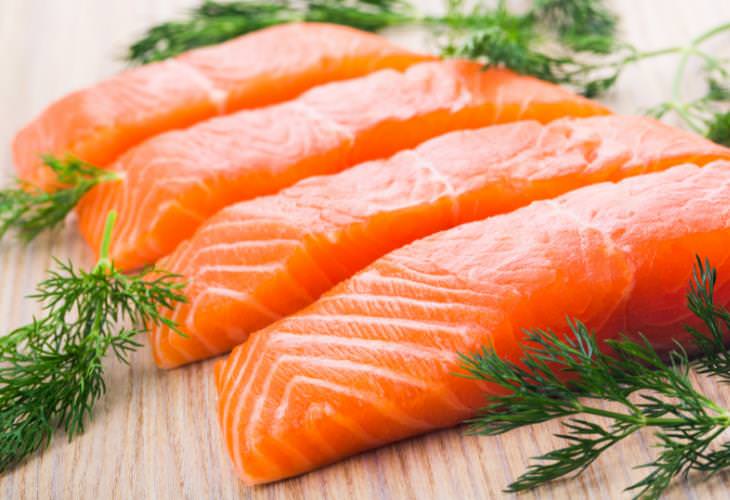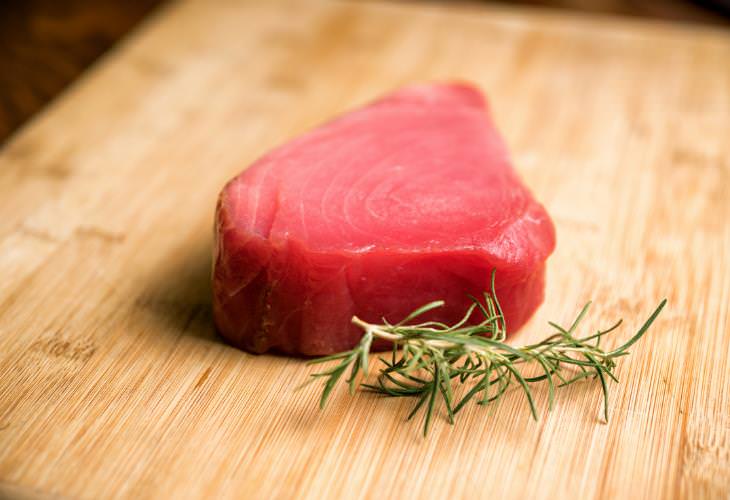Tuna, also known as 'tunny', are a group of large, muscular fish that belongs to the mackerel family. Depending on the variety, its color typically ranges from pink to dark red. Salmon, meanwhile, is a family of fish that live most of their adult lives at sea and have orange or pink flesh. Raw tuna is darker in color in comparison to raw salmon, because of the high level of myoglobin and iron in them.
Tuna and salmon are not too different in terms of taste. Tuna has a tender flavor and a flakier texture while salmon is oilier. Which one do you like more will depend on your individual taste.
Salmon and tuna can be used fresh or canned. Salmon’s strong flavor makes it a perfect addition to burgers, salads, and tartare. It also works wonderfully well with egg dishes, like quiche or egg muffins or as part of a rice or grain bowl.
Tuna is also quite versatile and its tender taste makes it ideal to add to dishes like sandwiches, sushi, salads, appetizers, soups, and spreads as it blends easily with other ingredients.
Nutrition Comparison
As we mentioned above, both salmon and tuna are highly nutritious. But how do the two perform in a head-to-head nutrition comparison? Based on the information provided by the United States Department of Agriculture, the nutrition information for 3 ounces (85g) of yellowfin tuna and 3 ounces (85g) of wild Atlantic Salmon are listed as below:
|
|
Tuna (3 oz.)
|
Salmon (3 oz.)
|
|
Calories
|
93
|
121
|
|
Fat
|
<1g
|
5g
|
|
Sodium
|
38mg
|
37mg
|
|
Fiber
|
0g
|
0g
|
|
Sugar
|
0g
|
0g
|
|
Protein
|
21g
|
17g
|
|
Vitamin D (IU)
|
40 IU
|
570 IU
|
|
Selenium (µg)
|
77 µg
|
31µg
|
|
Niacin (µg)
|
16 µg
|
6.7µg
|
|
Vitamin B12 (µg)
|
1.8µg
|
2.7µg
|
* As you can see from the table above, tuna has lower calories and fats. However, the primary fats found in salmon are polyunsaturated and monounsaturated fatty acids, which are the more favorable quality of fats. Tuna, meanwhile, is higher in saturated fats and too much of this fat can cause cholesterol to build up in your arteries.
* Salmon is high in vitamin D and contains more cholesterol. A 100 gm serving of salmon contains 55mg of cholesterol. The same amount of tuna has 38mg of cholesterol.
* In terms of protein, tuna scores a little better than salmon, albeit only marginally. That being said, the quality of protein found in both of them is terrific as both contain strong amounts of all essential amino acids.

* Salmon and tuna are also rich in vitamins and minerals. However, salmon can be considered a better source of proteins as it is higher in vitamins B2, B5, and B6, folate, along with vitamin D and vitamin E (3). Salmon also contains a small percentage of vitamin K which tuna doesn’t have.
* Both salmon and tuna are high in omega-3 fatty acids. According to the data provided by Seafood Health Facts, salmon provides 1,500mg of these fats per serving (of 3 ounces) as compared to tuna’s 1,000 to 1,500 mg.
* Salmon and tuna both don’t contain any carbohydrates, meaning that they don’t have any fiber or sugar. Their sodium content is also quite similar.
Health Benefits of Salmon

* As already stated, salmon is an omega-3 powerhouse. Omega-3s are necessary fats that are body can’t make on its own. They are known to reduce your risk of heart disease, increase your level of HDL cholesterol (the “good” kind) and potentially lower your LDL cholesterol (the “bad” kind). Research has also shown that these fats can reduce pain and inflammation in people with rheumatoid arthritis.
* The extra fat in salmon can help keep you fuller when compared to the low-fat content of tuna.
* Salmon also contains more vitamin B12 and vitamin D than tuna. Studies have shown that vitamin D can boost bone health, reduce inflammation and also improve mood. Vitamin B12, on the other hand, keeps the body's nerve and blood cells healthy, research has indicated.
Health Benefits of Tuna
* Just like salmon, tuna, too, is an excellent source of omega-3.
* Tuna is among the biggest dietary sources of selenium. This trace mineral is essential for a healthy immune system and, according to the United States Office of Dietary Supplements, also contributes to thyroid hormone metabolism and DNA synthesis.
* Tuna is low cal and low carb and packed with protein.
* Tuna can also help lower cholesterol with its high amount of niacin, a B vitamin. According to Mayo Clinic, niacin also helps keep your nervous system, digestive system, and skin healthy
The Bottom Line
As noted previously, both salmon and tuna offer plenty of health benefits. But if you want to understand which one’s better for you, you first need to review your health goals.
Both of these fishes are extremely nutritious and great sources of protein and nutrients to add to your diet. Tuna might be better for you if you’re trying to lose weight as it would be ideal for a low-calorie diet. But if you want to increase your omega-3 or Vitamin D intake, salmon would be your best choice.
Tuna also tends to have a higher mercury content than salmon. Mercury is a toxic heavy metal, and health experts warn that too much of it can harm health. Pregnant and/or breastfeeding women, particularly, should limit their consumption of high-mercury fish like tuna, according to the FDA.
Both these popular seafood choices are available in cans or pouches and are handy options for a quick meal. If you enjoy the taste of both tuna and salmon then you can incorporate them both into your diet in delicious ways. Alternate your consumption of both types of fishes and then you will get the benefits of omega-3 and vitamin D from salmon as well as lean protein from tuna.
Share this informative article with your loved ones...





